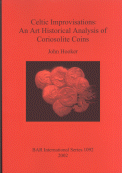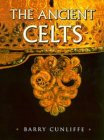


|
 |

Celtic Improvisations |
by
John Hooker; Pub.
British Archaeological Reports, 2002
|

The Ancient Celts |
by
Barry Cunliffe; Pub.
Penguin USA, 2000
Minimum reading level: Grade 12/1st year university |

The Celtic Empire: The First Millennium of Celtic History, 1000 BC - AD 51 |
by
Peter Berresford Ellis; Pub.
Avalon Publishing Group, New York, 2001
Minimum reading level: Grade 10 For those new to the subject, or for those infected by daft ideas. |
|
Celtic Improvisations is John Hooker's exhaustive ten-year study of the coins of these ancient Celts, using the development of the art as the major theme. Through the art, we begin to see through the eyes of the ancient Celtic artists, and learn what the symbols on the coins meant to them. This leads into the use and migration of the symbols, and their religious significance. The historical events that caused the minting of these coins is also examined, giving further insight into Celts, money, trade, and warfare. What emerges is a snapshot of the Coriosolite tribe around the time of Caesar’s invasion of Gaul.
Celtic Improvisations: An Art Historical Analysis of Coriosolite Coins, BAR S1092 2002, by John Hooker. 120 pages; illustrated throughout with b&w plans, maps, tables, drawings and photographs. "…The further strength of this engagingly-written study is its appeal to a wide range of interests: it is not just a catalogue of coins, but a case study of Celtic religious philosophy and aesthetics, referring to such apparently disparate subjects as poetry, physics, and psychology."
Order Celtic Improvisations now!
|
This is a very good survey that focuses, mainly, on the archaeology of the Celts, and is written by a prolific and respected authority. Barry Cunliffe is Professor of European Archaeology at the University of Oxford. As the range of the subject is vast, a single volume cannot, obviously, do it justice. Cunliffe takes the middle ground in many controversial areas, so few will find their favorite theories severely criticized. It is a very good book to start one's investigations, but understand that not all the evidence can be presented within the space restrictions of this volume. |
This book achieves what it sets out to do: to be an introductory history of the ancient Celts aimed at a general readership. Unlike more scholarly works, it does acknowledge some rather "fringe" authorship on the subject, and attempts to bring the followers of such to a more reasoned view. If you know someone who keeps insisting that the ancient Celts discovered America, then buy them this book. The author will sneak up on them, appearing, at first, to give some credit to a few ideas, and recognizing what the fringe author says that has any merit. But then, slowly and gently, the misconceptions are debunked. It is cleverly done. The author is both an historian and a novelist, and the writing style reflects this. It is a friendly book. |
|||
|
Diodorus of Sicily
Volume 3, Books 4 (59)-8, by
Diodorus Siculus; C. H. Oldfather (trans.) Pub.
Harvard, 1992
Minimum reading level: Grade 11 Useful source material for the customs of the ancient Celts. |

The Celts |
by
Heman Frey, Miklos Szabo, Barry Raftery, Venceslas Kruta, (eds.); Pub.
Rizzoli, New York, 1999.
719 pages. Over 1,000 illustrations. Minimum reading level: Grade 12/1st year university Useful for ideas and further research. |

The Conquest of Gaul |
by
Julius Caesar; S.A. Handford (trans.) Pub.
Penguin, New York, 1983
Minimum reading level: Grade 8 Useful for beginners to experts alike. |
|
| Diodorus gives us very useful information about the Celts, their warriors and their Druids within this book (other topics are also present). The translation is a little dated - almost nineteenth century in its style. We really need a new translation, but until then… | More than sixty essays covering a wide variety of topics by some eminent authorities, many who have contributed several entries. After more than ten years since the first edition of 1991, produced to accompany an exhibition on the Celts at the Palazzo Grassi in Venice, some of the information is dated. Don't let this discourage you, though, it is still a very useful book, especially if you are looking for themes to investigate further. It is an important milestone in Celtic studies and there is something here for everyone. | Yes, I said Grade 8. Caesar writes in an active and clear style, and Handford's elegant translation communicates this style very well. This book can be read for entertainment as well as serious study. It is the most detailed eye-witness account of the ancient Celts that we have. Some critics have said that we cannot trust this Roman's views, and that he had his own agenda, yet no one has ever caught Caesar out in an outright lie. Handford mentioned this fact in the introduction to an earlier edition, but there is now a new introduction by another author, and some more modern opinions have crept in. Critics of Caesar might have cause to wonder if their own writings could hold up so well after more than two thousand years, and their modern judgements actually reveal the timelessness of Caesar. It is exciting reading. Use it as source material for your thesis, or buy it for your 14-year-old son to read on a long trip as a break from his Game Boy. | |||

Celtic Art: From Its Beginnings to the Book of Kells |
by
Ruth and Vincent Megaw; Pub.
Thames and Hudson, New York, 2001
Minimum reading level: Grade 10 Useful for beginners to experts alike. |

Early Celtic Art in the British Isles
|
by E. M. Jope
Pub: Oxford University Press, Oxford, 2000
Minimum reading level: Grade 12/1st year university
E. M. Jope was Paul Jacobsthal’s assistant and worked with him on Early Celtic Art, a two-volume corpus on the Celtic Art of Europe. Early Celtic Art in the British Isles follows in this tradition and is the only corpus of British Celtic art since Sir Cyril Fox published Pattern and Purpose in 1958. |
||
Delightful to read and profusely illustrated in colour and b & w, this book is essential for anyone interested in Celtic art, and would also be very useful for those who study Celtic archaeology, religion or history. The writing style is clear and the reading flow is uninterrupted by footnotes or endnotes. At the end of the book is an excellent bibliography arranged thematically for each chapter. For example, the introduction has a bibliography arranged for thirteen themes, including Iron Age Europe, journals, horses and chariots, methods and techniques, importance of the Head to Celts, catalogues, and so on. There is also a very good index. From an academic point of view, there is barely a paragraph that could not inspire further thought or even original research. The Megaws present the reader with the varying ideas about some aspects of the subject when the current evidence is sparse. Although the writers are leading experts in this field, we never feel that we are being lectured to in a pedantic fashion, but instead are sharing with them the ongoing discovery of an often-elusive art form. If one could have only one book on Celtic art, this should be that book. This is a revised and expanded edition of the 1989 title presenting not only new discoveries of Celtic art, but recent thoughts about the subject generally. The production quality of the book is high – a permanent paperback with hard card covers printed on heavy coated stock and sewn in signatures. Reviewed by John Hooker. |
This is thus a highly important work and is the crowning achievement of the life of E. M. Jope. Sadly, he passed away before the book went to print. No serious student of Celtic art or the Iron Age archaeology of Britain can afford to be without this impressive work. If Jacobsthal’s work is anything to go on, then once Early Celtic Art in the British Isles goes out of print, it will soon be virtually impossible to find. I first learned of this work before it was completed, about ten years ago, in correspondence with the author. Martyn Jope told me he "was finishing" the book, so every year since then I inquired about the publication date. Like a carrot in front of my nose, the bookshops said it would be out "next year". Eventually it was published and I bought a copy. It was worth the wait. The first volume consists of the text: a discussion of the subject over nine chapters; the tenth chapter includes an annotated list of the items illustrated and an anatomy of insular early Celtic ornament. There are three appendices, including an important element analysis of the Battersea Shield red "enamel". These are followed by an extensive bibliography, a very useful glossary of terms and finally, and Index of Places. The second volume consists of 320 plates of the artifacts, most often with many illustrations to each plate. The illustrations consist of photographs and line drawings. Following in the tradition of Jacobsthal, Jope then provides over nine hundred line drawings of the patterns found on insular Celtic art arranged over another 12 plates. The books are large format, and should be read at a large desk or table where you can have both volumes open to read the text and refer to the pertinent illustrations. Despite the importance of this work, and the level of understanding that it imparts, Jope’s writing style is not only easy to read, but also it sparkles. His enthusiasm for his subject is infectious. Even though the set is not cheap, no serious scholar of the British Iron Age will be without it. Don’t expect to find it at your local library. With the ever-increasing costs of books and budgetary restraints, many libraries will not carry this title. This will also impact the availability of the title through inter-library loans. If you plan to write anything about the material culture of the British Iron Age you will need this work.Reviewed by John Hooker. |
||||